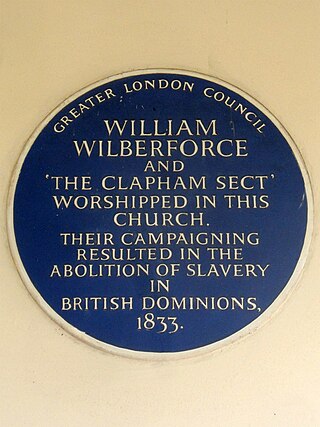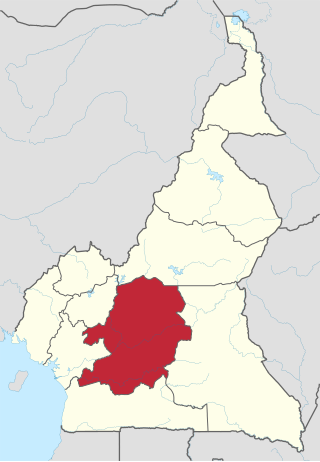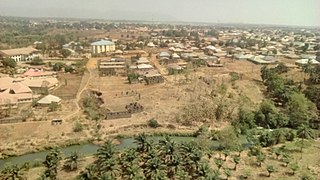
Malabo is the capital of Equatorial Guinea and the province of Bioko Norte. It is located on the north coast of the island of Bioko. In 2018, the city had a population of approximately 297,000 inhabitants.

The Clapham Sect, or Clapham Saints, were a group of social reformers associated with Holy Trinity Clapham in the period from the 1780s to the 1840s. Despite the label "sect", most members remained in the established Church of England, which was highly interwoven with offices of state. However, its successors were in many cases outside of the established Anglican Church.

Yaoundé is the capital of Cameroon and, with a population of more than 2.8 million, the second-largest city in the country after the port city Douala. It lies in the Centre Region of the nation at an elevation of about 750 metres (2,500 ft) above sea level.

The history of Missouri begins with settlement of the region by indigenous people during the Paleo-Indian period beginning in about 12,000 BC. Subsequent periods of native life emerged until the 17th century. New France set up small settlements, and in 1803, Napoleonic France sold the area to the U.S. as part of the Louisiana Purchase. Statehood for Missouri came following the Missouri Compromise in 1820 that allowed slavery. Settlement was rapid after 1820, aided by a network of rivers navigable by steamboats, centered in the City of St. Louis. It attracted European immigrants, especially Germans; the business community had a large Yankee element as well. The Civil War saw numerous small battles and control by the Union. After the war, its economy diversified, and railroads centered in Kansas City, opened up new farmlands in the west.

The Centre Region occupies 69,000 km2 of the central plains of the Republic of Cameroon. It is bordered to the north by the Adamawa Region, to the south by the South Region, to the east by the East Region, and to the West by the Littoral and West Regions. It is the second largest of Cameroon's regions in land area. Major ethnic groups include the Bassa, Ewondo, and Vute.

Fort Smith is a town in the South Slave Region of the Northwest Territories (NWT), Canada. It is located in the southeastern portion of the Northwest Territories, on the Slave River and adjacent to the Alberta border along the 60th parallel north.

Christian views on slavery are varied regionally, historically and spiritually. Slavery in various forms has been a part of the social environment for much of Christianity's history, spanning well over eighteen centuries. Saint Augustine described slavery as being against God's intention and resulting from sin. In the eighteenth century the abolition movement took shape among Christians across the globe.

Limbé or Limbe is a seaside city in the South-West Region of Cameroon, At the 2005 Census, the population was 84,223.

The Duala are a Bantu ethnic group of Cameroon. They primarily inhabit the littoral and southwest region of Cameroon and form a portion of the Sawabantu or "coastal people" of Cameroon. The Dualas readily welcomed German and French colonial policies. The number of German-speaking Africans increased in central African German colonies prior to 1914. The Duala leadership in 1884 placed the tribe under German rule. Most converted to Protestantism and were schooled along German lines. Colonial officials and businessmen preferred them as inexpensive clerks to German government offices and firms in Africa. They have historically played a highly influential role in Cameroon due to their long contact with Europeans, high rate of education, and wealth gained over centuries as slave traders and landowners.

The Subu are a Bantu ethnic group who inhabit part of the coast of Cameroon. Along with other coastal peoples, they belong to Cameroon's Sawa ethnic groups. They were one of the earliest Cameroonian peoples to make contact with Europeans, and over two centuries, they became influential traders and middlemen. Under the kings William I of Bimbia and Young King William, the Isubu formed a state called Bimbia.

Lewis Tappan was a New York abolitionist who dedicated his life efforts to securing freedom for the enslaved Africans aboard the Amistad. He was born in Northampton, Massachusetts, into a Calvinist household.

Colonial Nigeria was ruled by the British Empire from the mid-nineteenth century until 1 October 1960 when Nigeria achieved independence. Britain annexed Lagos in 1861 and established the Oil River Protectorate in 1884. British influence in the Niger area increased gradually over the 19th century, but Britain did not effectively occupy the area until 1885. Other European powers acknowledged Britain's dominance over the area in the 1885 Berlin Conference.

Kafanchan is a town located in the southern part of Kaduna State, Nigeria. The town owes much of its development to the railway development in the area. The railway is situated at a particular junction of the Nigerian Railway Corporation (NRC) station built in 1927. It sits on the railtrack connecting Port Harcourt, Enugu, Kafanchan, Kuru, Bauchi and finally Maiduguri. As of 2007, Kafanchan had an estimated population of 83,092.

William Ansah Sessarakoo, a prominent 18th-century Fante royal and diplomat, best known for his enslavement in the West Indies and diplomatic mission to England. He was both prominent among the Fante people and influential among Europeans concerned with the transatlantic slave trade.

Slavery in Britain existed before the Roman occupation and endured until the 11th century, when the Norman conquest of England resulted in the gradual merger of the pre-conquest institution of slavery into serfdom. Given the widespread socio-political changes, all slaves were no longer recognised separately in English law or custom. By the middle of the 12th century, the institution of slavery as it had existed prior to the Norman conquest had fully disappeared, but other forms of unfree servitude continued for some centuries.

The following outline is provided as an overview of and topical guide to Cameroon:

São Tomé and Príncipe, officially the Democratic Republic of São Tomé and Príncipe, is an island country in the Gulf of Guinea, the western equatorial coast of Central Africa.

The Catholic Church and slavery have a long and complicated history. Slavery was practiced and accepted by many cultures and religions around the world throughout history, including in ancient Rome. Passages in the Old Testament sanctioned forms of temporal slavery for Israelites as a means to repay a debt. Slaves, captured in war or purchased, and their children were enslaved for life. After Christianity was legalized under the Roman empire, sentiment grew that many kinds of slavery were incompatible with Christian justice. Views ranged from rejecting all forms of slavery to accepting slavery subject to certain restrictions. The Christian West almost entirely enforced that a free Christian could not be enslaved, for example as a captive in war. However, this was not consistently applied throughout history. The Middle Ages witnessed the emergence of orders of monks such as the Mercedarians who focused on ransoming Christian slaves. By the end of the Medieval period, enslavement of Christians had been largely abolished throughout Europe, although enslavement of non-Christians remained permissible and was revived in Spain and Portugal. Slavery remained a subject of debate within the Church for centuries, with several Popes issuing bulls on the issue, such as Sublimis Deus.

Bimbia was an independent state of the Isubu people of Cameroon. In 1884, it was annexed by the Germans and incorporated in the colony of Kamerun. It lies in Southwest Region, to the south of Mount Cameroon and to the west of the Wouri estuary. Is situated at the East coast of the Limbé sub-division.

Slavery in Niger involves different practices which have been practiced in the Sahel region for many centuries and which persist to this day. The Bornu Empire in the eastern part of Niger was an active part of the trans-Saharan slave trade for hundreds of years. Other ethnic groups in the country similarly had a history of slavery, although this varied and in some places slavery was largely limited to the political and economic elite.

















